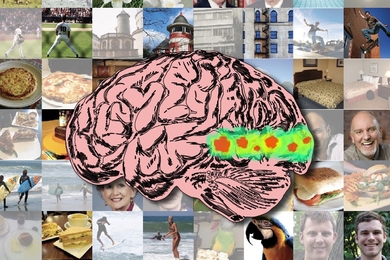MIT researchers have shown that a cocktail containing three compounds normally in the blood stream promotes growth of new brain connections and improves cognitive function in rodents. The treatment is now being tested in Alzheimer's patients and could hold promise for other brain diseases and injuries.
The mixture, which includes a type of omega-3 fatty acid, is part of a new approach to attacking Alzheimer's. That approach focuses on correcting the loss of synapses, or connections between neurons, which characterizes the disease.
For the past 30 years, researchers have tried targeting the clumps of misfolded proteins, known as amyloid beta plaques, found in the brains of Alzheimer's patients. However, that approach has not yielded any effective treatments for the disease, which affects an estimated four million to five million Americans.
"It's been very frustrating," said Richard Wurtman, the Cecil H. Green Distinguished Professor of Neuropharmacology and senior author of a paper on the new work published in the November issue of Brain Research. "Nobody has demonstrated that if you prevent formation of the amyloid, people get better."
In December, a group of Alzheimer's researchers, including Wurtman, will participate in a symposium with the goal of developing a public policy to promote new approaches to Alzheimer's research. Organizers of the symposium believe that the current system of dementia research is "broken" and needs to be fixed.
Alzheimer's researchers agree that the cognitive decline seen in Alzheimer's patients is caused by loss of brain synapses. Wurtman and others theorize that restoring some of those synapses could provide an effective treatment, analogous to giving L-dopa to Parkinson's patients. Such treatments don't cure the disease but can restore significant brain function, said Wurtman.
Synapses, where information is passed between neurons, play a critical role in learning and memory. Messages travel from a presynaptic neuron to a postsynaptic cell.
In the Brain Research paper, the MIT team reported that rodents given a cocktail of DHA (a type of omega-3 fatty acid), uridine and choline showed a greatly increased concentration of dendritic spines, which receive messages in the postsynaptic neuron. That indicates that synapse regeneration has occurred, which is unusual, Wurtman said.
Synapse regrowth could also prove an effective treatment for other brain diseases, such as Parkinson's, or for brain injuries, he said.
The researchers found that rodents who received the treatment performed much better on tests of cognitive ability (specifically, navigating a water maze). Sarah Holguin, an MIT graduate student in brain and cognitive sciences, presented those results at the Society for Neuroscience annual meeting earlier this month.
Some of the rats in the studies received all three compounds and some received only one. The improvements in synapse growth and cognitive ability were greatest in the rats given all three.
Omega-3 fatty acids are not produced in the body but are found in a variety of sources, including fish, eggs, flaxseed and meat from grass-fed animals. Choline can be synthesized in the body and obtained through the diet; it is found in meats, nuts and eggs. Uridine cannot be obtained from food sources, but is a component of human breast milk and can be produced in the body.
The cocktail of compounds is now in clinical studies in Europe.
Other authors of the Brain Research paper were Toshimasa Sakamoto, the first author and a research affiliate in the Department of Brain and Cognitive Sciences (BCS), and Mehmet Cansev, a BCS postdoctoral associate.
The research was funded by the National Institutes of Health and the Center for Brain Sciences and Metabolism Charitable Trust.
A version of this article appeared in MIT Tech Talk on November 28, 2007 (download PDF).





